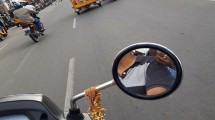Abstract
Since the estimation and provision of accurate travel speed or time information are essential for proper traffic management and successful ITS deployment, authors tried to identify the best detector locations for relatively long urban links. In most US cities, speed information is generally from loop detectors. In general, however, the data obtained loop detectors in freeways can be a good yardstick for representing the current travel speed and traffic condition. For arterials, however, speed estimation is not as e asy since some variant factors of arterials must also be considered. Factors considered included the following: number of lanes, linklen gth, green time, speed limit, and traffic volumes. With the help of CORSIM traffic simulation, it was found that the optimal detecto r location was mostly related to link length and green time, although the other factors of number of lanes, traffic volumes, and speed limits were not negligible. Conclusively, for relatively long links, approximately 2,000 ft in length, the optimal detector loc ations were identified to be about 200 ft from downstream intersection, for diverse green times of 20, 30, 40 and 50 seconds, respective vely. However, with the increase of link lengths, optimal locations were more dependent on green times. The detailed relationship between optimal detector placement and various link lengths/green times was shown. Some limitations and future research agenda were als o discussed.
Similar content being viewed by others
References
Federal Highway Administration (1998). “Traffic Software Integrated System Version 4.2 User’s Guide.”
Sisiopiku, V.P., Rouphail, N.M. and Santiago, A. (1994). “Analysis of correlation between arterial travel time and detector data from simulation and field studies.”Transportation Research Board, Vol. 1457, pp. 166–173.
Thomas, G.B. (1999). “Optimal Detector Location on Arterial Streets for Advanced Traveler Information System.” Ph.D. Dissertation, Arizona State University, Tempe, AZ, USA 12.
Author information
Authors and Affiliations
Corresponding authors
Rights and permissions
About this article
Cite this article
Oh, S., Choi, K. Optimal detector location for estimating link travel speed in urban arterial roads. KSCE J Civ Eng 8, 327–333 (2004). https://doi.org/10.1007/BF02836014
Received:
Accepted:
Issue Date:
DOI: https://doi.org/10.1007/BF02836014




